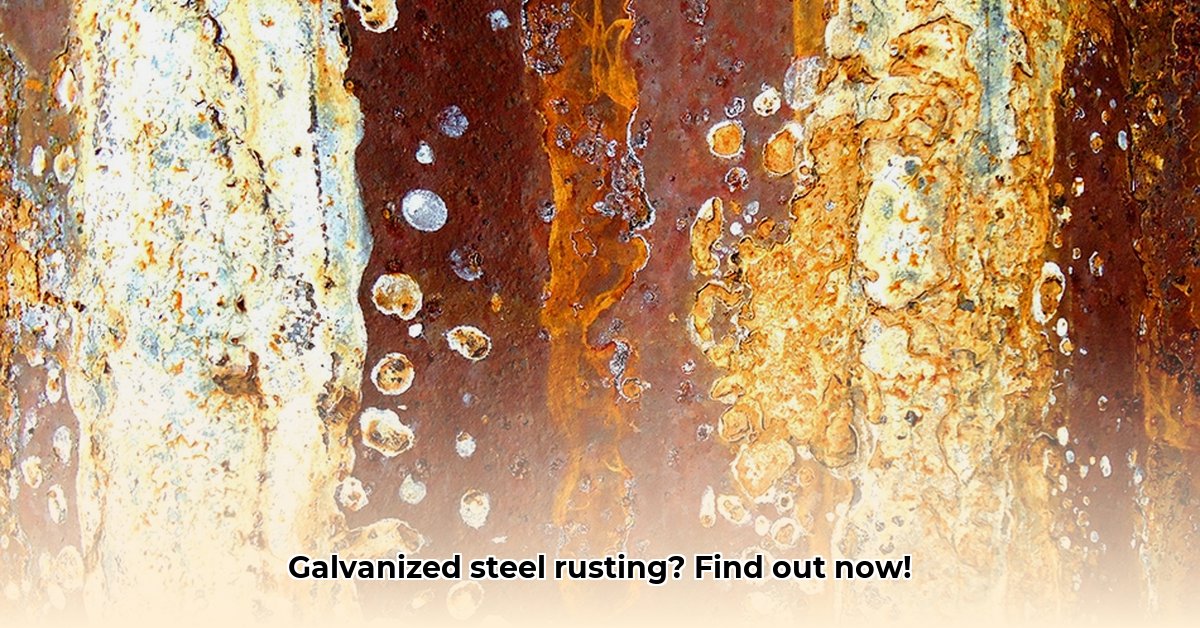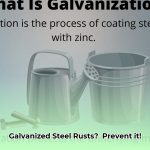Ever wonder if that galvanized steel fence or shed will eventually rust? The short answer is: it’s highly resistant, but not invincible! For more in-depth information, check out this helpful guide on galvanized steel rust here. This guide cuts through the technical jargon to explain exactly how galvanized steel works, what can make it rust, and – most importantly – how you can keep it looking great for years. We’ll cover everything from understanding the science behind that protective zinc coating to practical, easy-to-follow tips for maintenance and repair. Whether you’re a DIY enthusiast tackling a home project or a professional needing to understand the lifespan of your materials, you’ll find the information you need here. Let’s get started!
Understanding Galvanized Steel and Corrosion
Galvanized steel is known for its strength and resistance to rust. But will it ever corrode? The realistic answer is yes, under specific conditions. Understanding those conditions and how to mitigate them is key to maximizing its lifespan. Think of galvanized steel as a durable fortress; while strong, it still requires maintenance to withstand the test of time.
The Science Behind the Protection: Zinc’s Role
What makes galvanized steel so corrosion-resistant? The answer lies in its zinc coating. Applied through a process called hot-dip galvanizing, this coating creates a metallurgical bond with the steel, forming a robust barrier. More than just a physical shield, zinc acts as a “sacrificial anode.” This means that if moisture and electrolytes (like salt) reach the surface, the zinc will corrode before the steel. This process, known as galvanic corrosion, protects the underlying steel from rusting. The zinc slowly corrodes, preventing the underlying steel from rusting – protecting your investment for a longer time.
Factors That Accelerate Corrosion
Several factors can compromise the zinc coating and accelerate the corrosion process. Understanding these “enemies” is crucial for effective protection:
-
Coating Thickness: A thin zinc coating is like a flimsy shield. The less zinc, the faster the steel underneath will be exposed and begin to corrode. Thicker coatings, designated by standards like G90 or G185 (referring to the weight of zinc per square foot), provide significantly longer-lasting protection.
-
Environmental Conditions: Harsh environments drastically accelerate corrosion. Saltwater exposure in coastal regions, acid rain in industrial areas, and even consistently high humidity can weaken the zinc layer. These conditions introduce corrosive elements that constantly attack the protective coating, speeding up its degradation.
-
Physical Damage: Scratches, dents, and abrasions create direct pathways for moisture and oxygen to reach the steel. These breaches in the protective layer compromise the steel’s defense, leading to localized corrosion.
-
Contact with Dissimilar Metals: When galvanized steel comes into contact with other metals like copper or aluminum in the presence of an electrolyte (moisture), galvanic corrosion can occur. The more active metal (in this case, the zinc in galvanized steel) will corrode at an accelerated rate.
Maintenance: A Practical Guide to Extending Lifespan
Regular care is crucial for preserving the integrity of galvanized steel and preventing corrosion. Think of it as a routine health check for your steel structures:
Step 1: Routine Inspections: Inspect your galvanized steel structures at least twice a year, or quarterly in harsh environments. Look for any signs of damage, such as scratches, dents, white rust (a powdery zinc oxide), or red rust (indicating the steel is corroding).
Step 2: Gentle Cleaning: Use a mild detergent (like dish soap) and water to clean the surface. Remove any dirt, debris, salt deposits, or other contaminants. A soft brush or cloth is ideal – avoid abrasive cleaners, scouring pads, or high-pressure washers, as these can damage the zinc coating.
Step 3: Addressing Minor Damage: For small scratches or chips in the zinc coating, apply a zinc-rich cold galvanizing compound or paint according to the manufacturer’s instructions. Clean the area thoroughly before application, removing any loose rust or debris. This will restore the protective layer and prevent further corrosion.
Step 4: Preventing Contact with Incompatible Materials: Avoid direct contact between galvanized steel and dissimilar metals like copper or aluminum. Use insulating materials such as rubber washers or plastic spacers to separate them. Be mindful of water runoff from copper pipes or roofing, as it can accelerate corrosion of the galvanized steel below.
Galvanized Steel FAQs: Addressing Common Concerns
-
Q: I see white, powdery residue on my galvanized steel. Is that rust? A: That’s likely “white rust,” a zinc oxide that forms on new galvanized surfaces exposed to moisture. It’s generally not a major concern and can be removed with a mild cleaning solution. However, excessive white rust can indicate poor ventilation or prolonged exposure to moisture.
-
Q: Can I weld galvanized steel? A: Yes, but it requires special precautions. Welding burns off the zinc coating in the immediate vicinity of the weld, creating fumes that are hazardous to breathe. Use proper ventilation, wear a respirator, and remove the zinc coating before welding if possible. After welding, apply a zinc-rich coating to the weld area to restore corrosion protection.
-
Q: How long will my galvanized steel last? A: Lifespan varies greatly depending on the factors discussed above. In mild environments, it can last for 50 years or more. In harsh environments, it may only last for 10-20 years. Regular maintenance and proper material selection can significantly extend its lifespan.
Optimizing Protection: Choosing the Right Grade
Not all galvanized steel is created equal. The thickness of the zinc coating, and therefore its level of protection, varies. Common designations include G60, G90, and G185, with the number indicating the weight of zinc (in ounces) per square foot of surface area. For harsh environments, choose a higher grade like G90 or G185 for enhanced protection.
Tailored Strategies: Protecting Galvanized Steel across Industries
| Stakeholder | Short-Term Actions | Long-Term Strategies |
|---|---|---|
| Construction Crews | Implement careful handling procedures to prevent scratches and dents; use proper lifting techniques. | Develop comprehensive maintenance plans that include regular inspections, cleaning, and touch-up repairs; consider using thicker galvanized coatings. |
| Manufacturers | Optimize the galvanizing process to ensure uniform and adequate coating thickness; explore alternative coatings. | Invest in research and development to create even more durable and corrosion-resistant coatings, such as zinc-aluminum alloys or organic coatings. |
| Homeowners | Inspect galvanized steel structures regularly; clean them periodically with mild soap and water; repair any damage promptly. | Consider applying protective coatings such as paint or sealants; consult with a professional for advice on maintaining galvanized steel in your specific environment. |
By understanding the properties of galvanized steel, addressing potential corrosion risks, and implementing proactive maintenance strategies, you can significantly extend its lifespan and protect your investment.
Extending Lifespan in Harsh Environments
Key Takeaways:
- Galvanized steel relies on its zinc coating for rust resistance. Understanding the coating’s limitations is critical.
- Environmental conditions significantly impact lifespan. Coastal areas and industrial zones require extra precautions.
- Regular inspections and prompt repairs are essential for preserving the protective barrier.
- Choosing the right grade of galvanized steel for the intended environment is crucial.
- Protective coatings can provide an additional layer of defense against corrosion.
Prolonging Performance: Galvanized Steel and Rust Prevention
Galvanized steel’s ability to resist rust comes from the sacrificial zinc coating. This zinc layer not only prevents moisture and oxygen from reaching the steel, but also corrodes preferentially, protecting the underlying steel even when the coating is scratched. However, remember that this protection has limits.
Maximizing Longevity: Factors Affecting Durability
Several factors influence how long galvanized steel will last in harsh environments. The most important is the thickness of the zinc coating. Thicker coatings provide more sacrificial material and last longer. Environmental conditions, such as exposure to salt spray, industrial pollutants, and high humidity, accelerate corrosion. Finally, any physical damage to the zinc coating reduces its effectiveness and makes the steel more vulnerable.
Strategies: Protecting Galvanized Steel in Challenging Conditions
Here’s how to maximize the lifespan of galvanized steel in harsh environments:
- Selection of Appropriate Material: Choose galvanized steel with a heavy zinc coating (G90 or G185) for maximum protection. Consider additional coatings or treatments specifically designed for harsh environments.
- Regular Maintenance: Perform inspections more frequently (quarterly or even monthly) to identify any signs of corrosion early. Clean the surface regularly to remove salt, dirt, and other contaminants.
- Prompt Repairs: Repair any scratches, chips, or other damage to the zinc coating immediately. Use a zinc-rich repair compound to restore the protective barrier.
- Protective Coatings: Apply a protective coating, such as a specialized paint or sealant, to provide an extra layer of defense against corrosion. Choose a coating that is compatible with galvanized steel and designed for the specific environment.
- Environmental Modifications: If possible, modify the environment to reduce exposure to corrosive elements. For example, providing shelter from salt spray or improving ventilation to reduce humidity.
Troubleshooting: Addressing Common Problems
- Q: What if the rust is extensive? A: For extensive rust, consult a professional. The affected area may need to be replaced
- Vertical Axis Wind Turbine Design: Improving Efficiency and Overcoming Limits - October 29, 2025
- Wind Turbine to Power Home: Nacelle Design Improvements Advance - October 26, 2025
- Wind Turbine Blade Length: How Long Is Too Long? - October 24, 2025
















